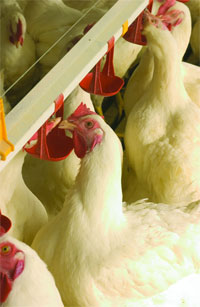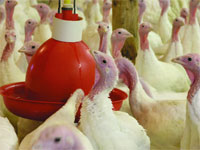
Controlling Respiratory Disease: Managing the poultry barn environment is key
By Tthe Technical Team Ziggity Systems Inc.
Features Profiles ResearchersRespiratory disease represents a significant threat to poultry flocks.
Strict adherence to good management practices throughout the poultry
operation, especially the watering system, is the only way poultry
producers can reduce the impact of respiratory disease on their flocks
and profits.
 |
| PREVENTING WET LITTER Controlling ammonia in the barn is key for reducing the incidence of respiratory disease. One strategy is to keep the litter dry by preventing leaky drinkers, removing biofilm and maintaining correct pressure. |

|
Respiratory disease represents a significant threat to poultry flocks. Strict adherence to good management practices throughout the poultry operation, especially the watering system, is the only way poultry producers can reduce the impact of respiratory disease on their flocks and profits.
If the birds are showing signs of infection, a producer can respond with medication. But all too often, the birds exhibit no signs of infection other than underperformance. Respiratory disease is not a single virus or bacteria; it generally is a complex of both, making prevention and treatment far more complicated. Even though farmers are vaccinating most flocks, respiratory lesions still turn up at slaughter on a regular basis; and these defects hurt weight gain and carcass quality.
The U.S. Department of Agriculture reports: “As we enter the 21st century, the single most important issue for poultry farmers will be how to lessen the direct and indirect cost of disease. A threshold has been reached where poultry farmers will have to either produce more birds to overcome the current cost of disease or produce the same amount of birds at a lesser cost with value-added disease control measures.”
The primary culprit in respiratory disease is ammonia, which is a result of moisture reacting with poultry droppings in the litter. Ammonia destroys the cilia in the chicken’s trachea. This leads to erosion of the tracheal lining. The irritated tracheal lining is more susceptible to infection by viruses or bacteria, and this can cause additional destruction of the trachea. Finally, E. coli bacteria from the litter gets into the trachea and the bird develops airsacculitis.
One strategy for controlling ammonia is to keep the litter dry; a second is to remove ammonia with ventilation. Ziggity recommends a combination of the two.
Litter in a poultry barn will always contain a certain amount of moisture, most of which comes from the birds themselves. Birds retain only about 30 per cent of the water they drink. About 20 per cent goes into the air as the birds exhale, and they excrete the remaining 50 per cent in their feces.
While some moisture in the litter is inevitable, farmers should strive to keep the moisture content to a minimum – about 20 to 25 per cent. This will keep the litter friable.
The following are some tips on how to keep the litter dry:
• Prevent leaky drinkers. Establish a regular program of high-pressure flushing for the watering system. This will remove biofilm and sediment buildups that can clog drinkers and cause them to leak. Ziggity recommends using a hydrogen peroxide-based cleaner to scrub the interior of the water pipes before flushing. Also, replace leaky drinkers immediately.
• Have adequate ventilation, summer and winter. Another reason for wet litter is inadequate ventilation to dry the litter and move the moisture out of the poultry barn.
• In cooler weather, you’ll find it necessary to heat the barn, not only to protect the birds from cold, but also to continue the evaporation process. Too often, farmers will attempt to save money by cutting back on heating. Research by University of Georgia poultry scientists shows, however, that the money saved on fuel is far outweighed by the money lost on underperforming birds as a result of elevated litter moisture and ammonia levels.
• Maintain correct pressure settings. During the drinking process, birds can only retain a certain amount of water in their beaks. If more water discharges from the drinker than what the bird can retain, the oversupply spills onto the litter. The key to achieving the correct pressure settings for your system is to take litter readings. Again, strive for friable litter.
• Many farmers use their watering system to vaccinate their flocks against respiratory disease. If you do, it is a good procedure to flush the water lines about 24 hours prior to vaccination to remove any biofilm and sediment in the lines. Then immediately after the vaccination, flush the lines again. This will remove any nutrients in the lines left over from the stock vaccine solution. Also, be sure that when you administer the vaccine, the lines are fully charged with the vaccine solution.
Ziggity Systems, Inc. is the only manufacturer 100 per cent focused on poultry watering for improved performance. For more information, write Ziggity Systems, Inc. at 101 Industrial Parkway, P.O. Box 1169, Middlebury, Indiana 46540-1169 USA, call +1 574.825.5849, fax +1 574.825.7674, or visit its website at www.ziggity.com .
Print this page